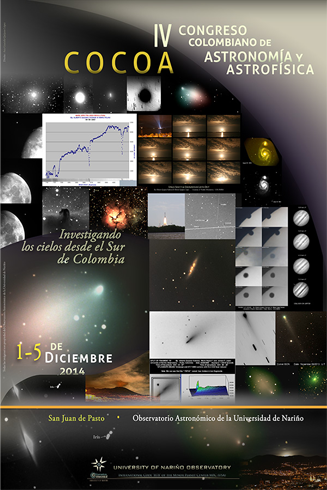Estudiando la parte central del cúmulo Alessi 21
Contenido principal del artículo
Resumen
Los cúmulos estelares jóvenes son de gran importancia ya que revelan la formación estelar y metalicidad en nuestra galaxia, ademas de ser regiones que comparten la misma cinemática estelar, presentan la misma metali-cidad y edad. En este trabajo estudiaremos el cúmulo estelar ALESSI 21 (edad ~30 millones de años) a través de fotometría en los filtros V, R, I del instrumento OSMOS acoplado al telescopio de 2.4m del observatorio MDM (Kitt Peak, Arizona). Se realizará una búsqueda de candidatas fotométricas y se determinará la región de pertenencia de las estrellas observadas en el cúmulo ALESSI 21 mediante la construcción de diagramas de color-color y color-magnitud, abarcando 20 minutos de arco en diámetro. Además nos planteamos estudiar los posibles discos de escombros masivos en este cúmulo empleando datos del Telescopio espacial WISE. Utili-zando diagramas punto vector, se podrá determinar cuales son los movimientos propios de miembros conocidos y candidatas fotométricas a través de la correlación de fuentes de 2MASS y el catálogo UCAC4, permitiendo así conocer más sobre la formación y evolución temprana de las estrellas y sus discos protoplanetarios.
Abstract
The young star clusters are very important because they reveal the star formation and metallicity in our galaxy, besides being regions that share the same kinematic stellar, have the same metallicity and age. In this paper we study the stellar cluster ALESSI 21 (age ~ 30 million years) through the filter photometry in V, R, I of the OSMOS instrument coupled to 2.4m telescope MDM Observatory (Kitt Peak, Arizona). Search photometric candidates will be conducted and the region membership of the stars observed in the cluster ALESSI 21 by constructing color-color diagrams and color-magnitude is determined, covering 20 minutes of arc in diameter. In addition we plan to study the possible massive debris disks in this cluster using WISE Space Telescope data. Using diagrams point-vector, may determine what the proper motions of known members and photometric candidates through the correlation of sources 2MASS and UCAC4 catalog, allowing learn more about the for-mation and early evolution of stars and protoplanetary disks.

